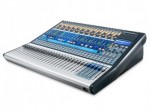Mixing Desks
- Midas Pro 2 Mixing Console
- Yamaha LS9
- Presonus StudioLive 24
- Soundcraft Vi1
Mixing Desks come in a variety of shapes and sizes, ranging from a simple 4 channel mixer right the way up to 96 or even 128 channel mixers. In Live events you tend to most commonly see 24, 32, or 48 channel mixing desks.
In recent years there has been a big boom in digital mixing consoles. This is mainly due to the fact that they significantly reduce the amount of kit required than if you are using an analogue system. This is because digital mixing desks have built in on board virtual effects units that can have any part of the desk routed through them simply. This means no outboard effects units in another heavy flight case that you have to take to every gig you do, saving you money, space and time during the get in where you spend a good 15 minutes routing auxes to your outboard units. You could be using that time for sound check.
At the moment a popular make of digital mixing desk is the Yamaha LS9. It is a significant leader in its market due to its size and its power as a desk. 8 on board virtual rack units that are completely assignable to any part of the desk, and up to 64 separate channels of audio when using a fully digital system or up to 32 channels on a part digital system. Remarkable this desk can be carried by one person!
But many other digital mixers are out there. Allen&Heath have the iLive series, Midas with the Pro Series (bit on the expensive side mind you, but very powerful) and Soundcraft with Si and Vi series. Plus many others
Choosing the right one comes down to a number of elements. But primarily it’s the user experience. Each maker of digital mixing desk have their own slant on how a digital mixing desk looks and feels, some prefer Allen&Heath’s concept more than others, whereas other will say that Yamaha’s concept is best. It all depends on how you prefer working but it is strongly recommended you try before you buy.
Other elements are of course the requirements for you show, for example you don’t need a 48 channel mixing desk if you are only going to be using 20 of them. But also quite significantly is money. Most of the model stated above are plus £10,000, with the exception to the LS9 which is below that price.
If you are like most, strapped for cash and cannot afford even an LS9 it is worth mentioning that there are others like Presonus for example who make a 24 channel digital mixing desk with firewire recording capability for just under £3000. Plus with their analogue-like user interface they are a great starting point to move from traditional analogue mixers and into the digital realm.



